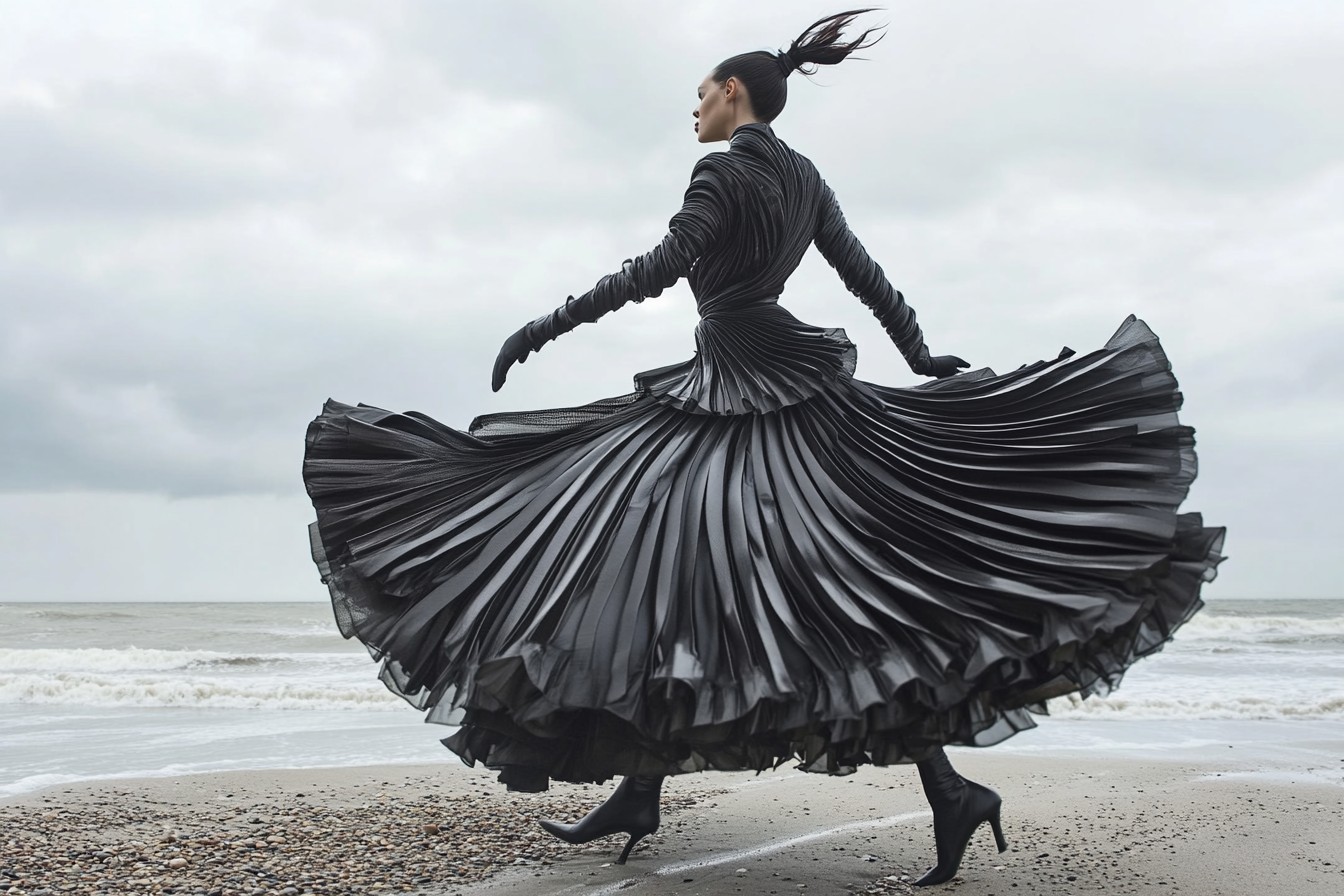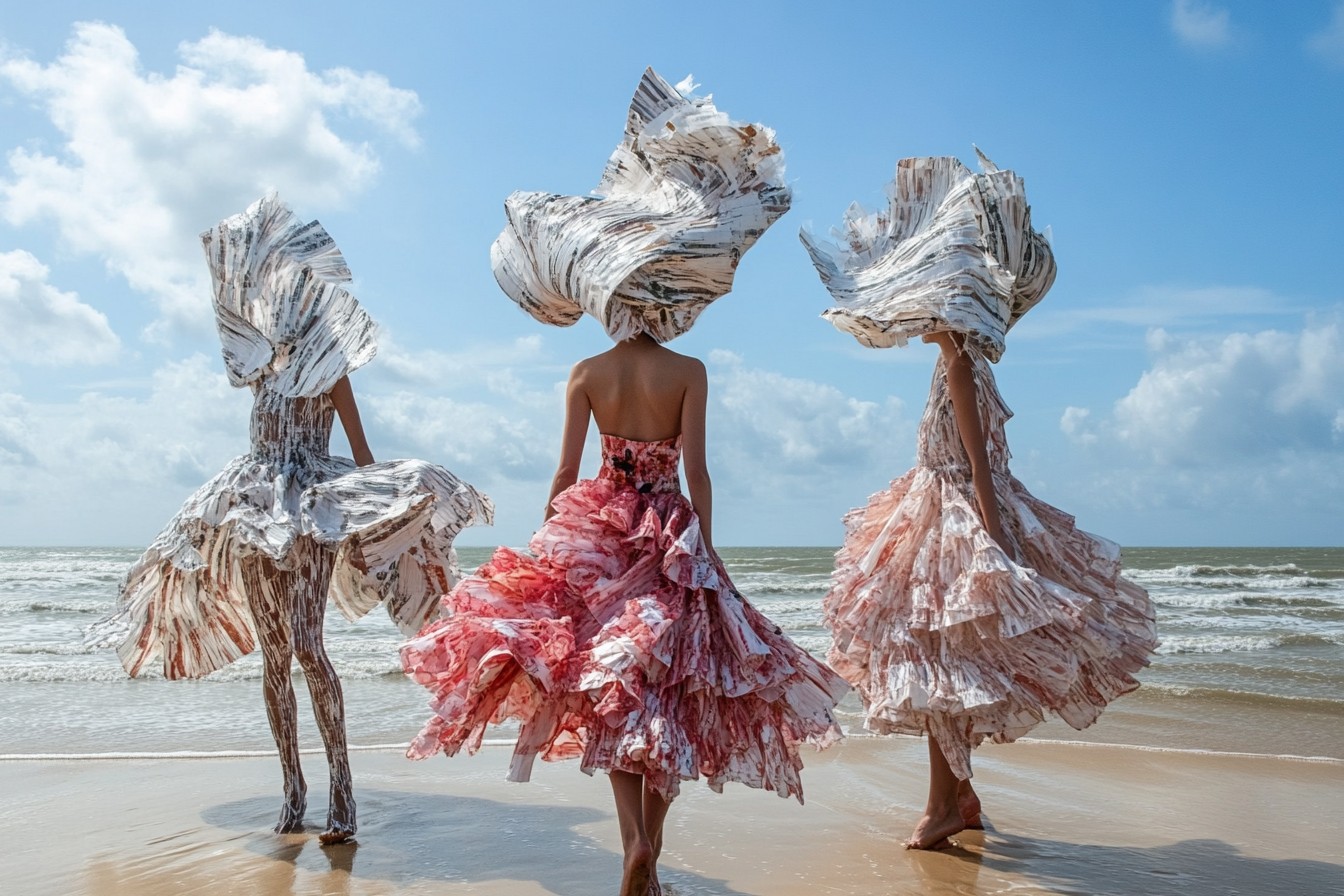The British beach holiday is a triumph of optimism over meteorological reality. Show me someone packing a suitcase for a UK coastal break, and I’ll show you someone who’s included both sunscreen and a raincoat, flip-flops and waterproof boots, a swimming costume and a chunky knit jumper. We are a nation of weather-hedgers, forced by our gloriously unpredictable climate to prepare for four seasons in a single day, especially when that day involves sitting exposed on a shoreline somewhere.

I learned this lesson the hard way during my first “grown-up” beach trip, a weekend to Whitstable with university friends. Having spent the previous summer interning at a fashion magazine where everyone dressed as if permanently en route to the Côte d’Azur, I packed accordingly—flimsy sundresses, impractical sandals, and absolutely nothing waterproof. Cue horizontal rain, temperatures that wouldn’t have been out of place in November, and me wearing every item I’d brought simultaneously while still shivering dramatically. My friends, all seasoned British holidaymakers, watched with a mixture of pity and amusement as I discovered that British beach attire has very little in common with its Mediterranean counterpart.
Since then, I’ve become something of a student of our peculiarly British approach to beach dressing—an approach that varies not just with the weather, but with the specific geography, social context, and unwritten rules of each coastal location. Because make no mistake: what works on Brighton’s urban pebble beach would look entirely out of place on Bamburgh’s vast, windswept sands. The appropriate attire for a day at genteel Southwold bears little resemblance to what you’d wear to surf-centric Newquay.
Let’s start with Brighton, shall we? As London’s unofficial seaside annex, Brighton beach has a distinctly urban energy. This is not a place for traditional seaside attire—no bucket hats or sensible sandals here. Instead, Brighton embraces a kind of performative beach style that acknowledges you’re as likely to end up in a beachfront bar or vintage shop as actually sitting on the pebbles.

The pebbles themselves are key to Brighton beach attire. Unlike sand, pebbles heat up significantly in the sun, making proper footwear essential. Flimsy flip-flops provide approximately zero protection from the hot stones’ quite literal assault on your soles. Instead, Brighton regulars opt for substantial sandals with proper straps (think Birkenstocks or their numerous imitators), canvas trainers that can be easily slipped on and off, or even Crocs, which have undergone an ironic-to-unironic rehabilitation among the city’s more fashion-forward residents.
“You can always spot tourists on Brighton beach,” my friend Sadie, a Brighton native, told me. “They’re the ones awkwardly hobbling across the pebbles in inadequate footwear, looking like they’re walking on hot coals.” The locals, meanwhile, navigate the terrain with practiced ease, their feet appropriately armored against the terrain.
Brighton’s proximity to London and its reputation as a hub for creative industries influences its beach style significantly. There’s a studied casualness that nevertheless communicates fashion awareness—vintage Levi’s cut-offs rather than generic denim shorts, oversized linen shirts from independent boutiques rather than high street beach cover-ups, interesting sunglasses that suggest you might work in media or design.

The city’s strong LGBTQ+ culture and history of counterculture also encourage more experimental dressing than you’d see at traditional seaside resorts. During Pride weekend and other events, the beach becomes a riot of color and creative expression, but even on ordinary summer days, there’s less adherence to conventional beachwear rules. Men in brief swim shorts that would raise eyebrows in more conservative coastal towns are commonplace, as are women in vintage-inspired high-waisted bikinis or swimming costumes with a fashion rather than purely practical focus.
Travel east along the coast to Whitstable, and the beach aesthetic shifts noticeably. Here, the London influence remains strong (given the town’s popularity with weekending city-dwellers), but with a more deliberately relaxed, maritime-inspired approach. Breton tops are practically the unofficial uniform, worn with white or navy linen trousers rolled up at the ankle, canvas espadrilles, and straw market baskets that do double duty for beach essentials and the obligatory visit to the town’s famous food markets.
Whitstable’s pebbly beach and foodie culture mean that beachwear often needs to transition easily to seafood restaurants and pub gardens. This has created a distinctly practical but presentable approach—natural fabrics that don’t look out of place with a glass of white wine and a plate of the town’s famous oysters. Think linen shirts, cotton dresses that won’t blow up in the coastal breeze, and layers that can be added or removed as the temperamental Kentish weather dictates.

“In Whitstable, you’re dressing for the whole experience, not just the beach,” explained my friend Leila, who has a weekend cottage there. “You might start on the beach, then grab lunch at the Lobster Shack, browse some galleries, and end up in a pub garden. Your outfit needs to work for all of that.” This translates to a sort of casual-but-considered approach—nothing too precious that can’t handle a bit of sea spray, but nothing so beach-specific that it would look odd with a glass of wine.
Moving to the Suffolk coast, places like Southwold and Aldeburgh embody a more traditional, quintessentially English approach to seaside dressing. Here, the influence of old-school British holiday traditions remains strong, updated with elements of the rural-luxe aesthetic that characterizes much of the region’s tourism.
“Southwold has quite a specific look,” noted my editor, who has a family home there. “It’s very Home Counties middle-class—Crew Clothing, Joules, White Stuff, Seasalt. Lots of navy blue, stripes, and understated prints.” Beach attire here often includes elements that would be equally at home at a countryside pub lunch—Barbour jackets for when the wind picks up, boat shoes rather than flip-flops, cotton Breton dresses, and quality basics that communicate a certain understated affluence.

The beach huts that line Southwold’s promenade create a distinctive beach culture where sitting outside your hut (often decorated in complementary coastal colors) is as much a part of the experience as being on the sand itself. This has fostered a kind of beach-adjacent dressing rather than traditional swimwear-focused beachwear—cover-ups that are destinations in themselves rather than just something to throw over a swimming costume, proper sun hats with brims substantial enough to offer actual protection, and always, always layers to account for the reliable unreliability of the East Anglican weather.
Head southwest to Cornwall, and beach attire undergoes another transformation, particularly in surf-centric towns like Newquay. Here, genuine technical beachwear dominates—high-performance wetsuits from brands like Finisterre and Rip Curl, specialist surfing swimwear that prioritizes staying in place over fashionable cuts, and a general sense that the beach is for activities rather than just posing.
“The serious surfers are easy to spot,” my friend Tom, who moved to Newquay from London five years ago, told me. “They’re the ones who look completely unfazed by the weather, wearing decent wetsuits regardless of the season and carrying boards that look well-used rather than freshly purchased.” Tourists, meanwhile, can be identified by their brand new surf-inspired gear, often from mainstream brands rather than the specialist local outfitters that locals prefer.

Even non-surfers in Cornwall tend to adopt a more active, practical approach to beach attire. Quick-dry shorts, technical sandals that can handle rock pools and coastal paths, and lightweight layers that can be easily stashed in a backpack are the norm. There’s less emphasis on looking styled for Instagram and more on being properly equipped for whatever the Atlantic might throw at you—which, given Cornwall’s exposed position, could be anything from glorious sunshine to sideways rain within the same hour.
The north Devon coast shares some of Cornwall’s surf culture but with its own distinct character. Places like Woolacombe combine traditional British seaside elements with more adventure-focused apparel. Here, you’ll see families in classic beach attire—bucket hats, sensible swimwear, beach tents laden with provisions for a full day on the sand—alongside surf enthusiasts in technical gear and walkers dressed for the South West Coast Path that runs along the cliffstops.
“Devon beaches require a bit of strategic dressing,” explained my cousin Rachel, who holidays there regularly with her young family. “The beaches themselves can be gloriously warm if the sun’s out, but the walk down to them often involves steep paths where you’ll catch the full force of the wind. So we always dress in layers and pack for multiple weather scenarios.” This typically means swimwear with easy cover-ups, sweatshirts or light jackets that can be tied around waists when not needed, and footwear that can handle both sand and the often challenging approaches to the beach.

As we move up to the Welsh coast, the beaches of Pembrokeshire and the Gower Peninsula have their own distinctive dress codes. These beaches, often rated among the most beautiful in the world but blessed with decidedly un-Mediterranean weather patterns, call for a practical approach with certain regional quirks.
“Welsh beaches have this wild beauty that demands respect,” my Welsh friend Rhian pointed out. “You need to be prepared for the elements changing quickly.” This translates to local beachgoers often carrying more substantial weather protection than you’d see in the southeast—proper waterproof jackets rather than just light windbreakers, walking shoes that can handle both beach and the often muddy paths leading to them, and always, always layers.
The strong outdoor activity culture in Wales also influences beach attire. Many beachgoers combine their coastal visits with walks along the stunning Pembrokeshire Coast Path or other outdoor pursuits, meaning that technical clothing from brands like Rab and Mountain Equipment is a common sight, even on summer days. Swimming is a serious business too, with wild swimming growing in popularity. This has led to increased sightings of dryrobe-style changing robes, swimming shoes for rocky entries, and other specialized gear that prioritizes function over conventional beach fashion.

Heading north to the vast, often windswept beaches of Northumberland, we enter another beach-style ecosystem entirely. Beaches like Bamburgh, with its dramatic castle backdrop and enormous expanse of sand, create a distinctive approach to coastal dressing that acknowledges the often challenging North Sea conditions.
“You’ve got to understand that even in summer, a Northumberland beach can feel like winter anywhere else if the wind’s coming off the North Sea,” explained my editor’s husband, who grew up in the area. “So people dress with that in mind—layers are essential, and you’ll rarely see the kind of minimal beachwear you’d find further south.”
What you will see are serious walkers dressed for the coastal paths, families equipped for full days out with windbreaks and substantial picnic setups, and hardy swimmers in wetsuits regardless of the season. The fashion element is minimal here—function dominates, with durable, weather-resistant clothing from outdoor brands taking precedence over trend-led beachwear. Dogs are almost as common as people on many Northumberland beaches, adding another practical element to the attire—pockets for treats, shoes that can handle both sand and mud, and clothes that can withstand enthusiastic shaking after doggy swimming sessions.

Scottish beaches represent perhaps the most extreme example of the British talent for optimistic beach dressing. On the rare perfect summer day, beaches like Luskentyre on Harris can rival any tropical paradise for beauty—and on such days, locals make the most of it, though rarely with the abandon of their southern counterparts.
“There’s always an element of weather-readiness on Scottish beaches,” my Scottish friend Isla explained. “Even on the most beautiful day, people bring layers, windbreakers, sometimes even hot drinks in flasks. We know how quickly it can change.” This creates a distinctive beach style where swimming costumes might be worn under easily-added layers, shoes are almost always practical rather than purely decorative, and cover-ups tend to be substantial enough to provide actual warmth rather than just modest coverage.
The wild swimming movement has gained particular traction in Scotland, bringing with it specialized gear for cold-water immersion—changing robes, neoprene gloves and boots, swim caps, and other accessories that acknowledge the genuinely challenging conditions. This technical approach extends to general beachwear too, with quality outdoor brands like Finisterre, Fjällräven, and local Scottish companies like Hilltrek featuring prominently in coastal attire.
What’s fascinating across all these regional variations is how they’re influenced not just by weather conditions but by the physical characteristics of the beaches themselves and the social context surrounding them. Sandy beaches encourage different footwear choices than pebbly ones. Beaches near urban centers with strong bar and restaurant cultures require outfits that can transition from sand to social settings. Beaches known for outdoor activities foster more technical, performance-focused attire.
There are temporal variations too—the British beach in high summer looks very different from the same location in spring or autumn, when it’s largely the domain of dog walkers, outdoor enthusiasts, and locals. Winter sees another transformation, with beaches becoming the preserve of the truly hardy—wild swimmers in full cold-water gear, walkers bundled against the elements, and the occasional photographer capturing moody seascapes.
For anyone planning a British beach holiday, understanding these regional variations isn’t just about fitting in (though there is a certain comfort in not standing out as obviously unprepared). It’s about being properly equipped for the specific joys and challenges of each coastal location, allowing you to enjoy the experience rather than fighting against inappropriate clothing choices.
My own beach bag has evolved significantly since that disastrous Whitstable weekend. It now invariably contains layers (regardless of the forecast), footwear appropriate to the specific beach surface, a substantial hat that won’t blow away in the first coastal breeze, and always, always a waterproof layer within easy reach. I’ve learned to check not just the temperature forecast but the wind strength and direction, which can transform a seemingly perfect beach day into an endurance test in minutes.
I’ve also embraced the distinct character of different coastal regions, adapting my approach depending on location. For Brighton, I’ll pack more urban-appropriate items that can transition from beach to bar. For Cornwall, more active, technical pieces that can handle a coastal path walk or an impromptu decision to try body-boarding. For Northumberland, enough layers to survive an unexpected Arctic front moving in from the North Sea.
The British beach holiday may require more wardrobe planning than its Mediterranean counterpart, but there’s something rather wonderful about our determination to enjoy our coastline regardless of conditions. We may not have guaranteed sunshine, but we have some of the most beautiful and varied coastal landscapes in the world—and as long as you’ve packed appropriately, there’s joy to be found on a British beach in almost any weather. Just don’t forget the thermos, even in August. Trust me on this one.

Leave a Reply